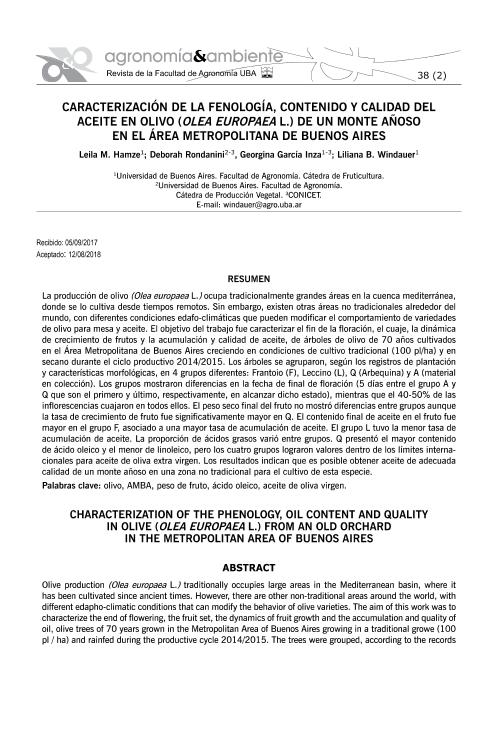Artículo
La producción de olivo (Olea europaea L.) ocupa tradicionalmente grandes áreas en la cuenca mediterránea,donde se lo cultiva desde tiempos remotos. Sin embargo, existen otras áreas no tradicionales alrededor delmundo, con diferentes condiciones edafo-climáticas que pueden modificar el comportamiento de variedadesde olivo para mesa y aceite. El objetivo del trabajo fue caracterizar el fin de la floración, el cuaje, la dinámicade crecimiento de frutos y la acumulación y calidad de aceite, de árboles de olivo de 70 años cultivadosen el Área Metropolitana de Buenos Aires creciendo en condiciones de cultivo tradicional (100 pl/ha) y ensecano durante el ciclo productivo 2014/2015. Los árboles se agruparon, según los registros de plantacióny características morfológicas, en 4 grupos diferentes: Frantoio (F), Leccino (L), Q (Arbequina) y A (materialen colección). Los grupos mostraron diferencias en la fecha de final de floración (5 días entre el grupo A yQ que son el primero y último, respectivamente, en alcanzar dicho estado), mientras que el 40-50% de lasinflorescencias cuajaron en todos ellos. El peso seco final del fruto no mostró diferencias entre grupos aunquela tasa de crecimiento de fruto fue significativamente mayor en Q. El contenido final de aceite en el fruto fuemayor en el grupo F, asociado a una mayor tasa de acumulación de aceite. El grupo L tuvo la menor tasa deacumulación de aceite. La proporción de ácidos grasos varió entre grupos. Q presentó el mayor contenidode ácido oleico y el menor de linoleico, pero los cuatro grupos lograron valores dentro de los límites internacionales para aceite de oliva extra virgen. Los resultados indican que es posible obtener aceite de adecuadacalidad de un monte añoso en una zona no tradicional para el cultivo de esta especie. Olive production (Olea europaea L.) traditionally occupies large areas in the Mediterranean basin, where it has been cultivated since ancient times. However, there are other non-traditional areas around the world, with different edapho-climatic conditions that can modify the behavior of olive varieties. The aim of this work was to characterize the end of flowering, the fruit set, the dynamics of fruit growth and the accumulation and quality of oil, olive trees of 70 years grown in the Metropolitan Area of Buenos Aires growing in a traditional growe (100 pl / ha) and rainfed during the productive cycle 2014/2015. The trees were grouped, according to the records of planting and morphological characteristics, into 4 different groups named: F, L, Q and A. The groups showed differences in the end date of flowering (5 days between group A and Q which are the first and last, respectively, to reach this state), while 40-50% of the inflorescences set in all of them. The final dry weight of the fruit showed no differences between groups although the fruit growth rate was significantly higher in Q. The final oil content in the fruit was higher in group F, associated with a higher rate of oil accumulation. Group L had the lowest rate of oil accumulation. The proportion of fatty acids varied between groups. Q presented the highest oleic acid content and the lowest linoleic content, but the four groups achieved values within the international limits for extra virgin olive oil. The results indicate that it is possible to obtain oil of adequate quality from an old orchard in a non-traditional zone for the cultivation of this species.
Caracterización de la fenología, contenido y calidad del aceite en olivo (Olea europaea L.) de un monte añoso en el Área Metropolitana de Buenos Aires
Título:
Characterization of the phenology, oil content and quality in olive (Olea europaea L.) from an old orchard in the Metropolitan Area of Buenos Aires
Hamze, Leila Mariam ; Rondanini, Deborah Paola
; Rondanini, Deborah Paola ; García Inza, Georgina Paula
; García Inza, Georgina Paula ; Windauer, Liliana Beatriz
; Windauer, Liliana Beatriz
 ; Rondanini, Deborah Paola
; Rondanini, Deborah Paola ; García Inza, Georgina Paula
; García Inza, Georgina Paula ; Windauer, Liliana Beatriz
; Windauer, Liliana Beatriz
Fecha de publicación:
08/2018
Editorial:
Universidad de Buenos Aires. Facultad de Agronomía
Revista:
Agronomía&Ambiente
ISSN:
2314-2243
Idioma:
Español
Tipo de recurso:
Artículo publicado
Clasificación temática:
Resumen
Palabras clave:
Olivo
,
Peso de fruto
,
ácido oleico
,
Aceite de oliva virgen
,
AMBA
Archivos asociados
Licencia
Identificadores
Colecciones
Articulos(OCA PQUE. CENTENARIO)
Articulos de OFICINA DE COORDINACION ADMINISTRATIVA PQUE. CENTENARIO
Articulos de OFICINA DE COORDINACION ADMINISTRATIVA PQUE. CENTENARIO
Citación
Hamze, Leila Mariam; Rondanini, Deborah Paola; García Inza, Georgina Paula; Windauer, Liliana Beatriz; Caracterización de la fenología, contenido y calidad del aceite en olivo (Olea europaea L.) de un monte añoso en el Área Metropolitana de Buenos Aires; Universidad de Buenos Aires. Facultad de Agronomía; Agronomía&Ambiente; 38; 2; 8-2018; 1-14
Compartir



